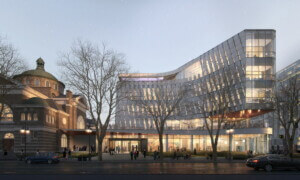When Zaha Hadid passed away this March, many questioned the future of her practice, Zaha Hadid Architects (ZHA). As its leader, the Iraq-born British architect had played a starring role in the international design scene. Since her passing, ZHA has continued with Patrik Schumacher, the firm’s only former partner, at its helm. Schumacher spoke with AN’s Senior Editor Matt Shaw about what the future holds for ZHA, the impact of starchitecture, progressive urbanism, and more.
The Architect’s Newspaper: How will ZHA continue? Do you feel like you have a good team behind you?
Patrik Schumacher: Oh absolutely we have a great team [and] many layers of people who have been with us for many, many years. A lot of them are former students of mine. There’s a…much-shared sensibility and set of values—let’s say the DNA of the firm—deeply embedded in everybody’s way of working. It’s also not just about being ambitious about ZHA, but being ambitious about giving leadership to the discipline as a whole. This is something I’ve been doing through my writings and attempting to do. There’s also the effort to overcome some of the prejudice, which the firm has faced through some of its critics.
What do you make of ZHA’s criticisms?
I think this is based on a lack of understanding of our motivations. I’m trying to address this and I want to be more open to engagement with critics [by] explaining what we’re really about. We don’t want to be stars. We don’t want to become rich quick. We’re not insensitive to social and political issues. We actually share a lot with those critical of our work, critics who sometimes seem to take the moral high ground. What we all share, and should be expected to share as a basis for conversation, is a commitment to societal development, progress, emancipation, freedom, prosperity, and attempt to make architecture relevant to [the] development of the city and society. These kinds of shared motivations should be a basis for a conversation, [one that] also respects that maybe we see clients differently. We at ZHA see society’s development differently and I’m willing to talk about my optimism for more market-based organization processes and entrepreneurial solutions to societal problems. Solutions to maybe what we can perceive to be certain economic statements and stagnation in recent years.
Do you think that as the discussion around Zaha Architects changes from one of a star to a system there will be a change?
I think it’s very important because the starchitecture discourse, when the phrase comes up, always has negative connotations of superficiality, celebrity cult, etc. It was very unhelpful to us and certainly not something we or even Zaha was ever aiming for. It’s just not helpful. People become well-known because of a certain merit, because of an inspirational flavor and input of their work into the field. It is generated initially within the discipline through a form of peer recognition before being carried out into the public at large. At that point, some of the reasons why a person became well known get lost and you just have a free floating celebrity. That’s not helping. I don’t think that I’m aspiring to this, nor would I achieve this. At ZHA, we want to focus more on the ideas, principles, and, of course, with respect to society at large and the clients [with whom] we had established a reputation. Colleagues and critics should be able to realize that this is not only a superficial reputation, but a reputation which has reasons to back it up.
I’ve been saying that the discourse on icons is misguided in many ways. Iconography, in a positive sense, is something that becomes conspicuous because it’s innovative and has been rigorously developed from principles. Conspicuity, recognizability, and strangeness can be seen as side-effects even when the act of being iconic is not the driver or the original motif. Instead, it’s a temporary inevitability.
If you look at the Seagram building in New York when it arrived on the scene in the 1950s, it had the shock of a different form of “new.” It was incredibly iconic and of a totally new civilization. However, this is only a temporary condition. Now the city has been remade in its image and you hardly notice it. Only architects who are aware of this notice. That is the way we should look at some of our work. As temporarily conspicuous and not necessarily something which we are craving for. Our work is not meant to be a spectacle and this is important to realize because it can very easily become a target for icon and star bashing. This is incredibly unhelpful because it’s no longer talking about the merit and demerit the of the work, its arguments, and the innovative thrust of a project, but rather its superficial celebrity status.
Do you see the parametricism as being the “next modernism?”
Yes, though they have very different technological social paradigms. This civilization has evolved into a new condition and, as a result, the built environment is bound to change with it. In fact, it has been continuously changing but in ways which the discipline so far hasn’t impacted it sufficiently. If parametricism does not become hegemonic like modernism was in the 1960s, then it means that the discipline has become impotent. Currently, we have retro styles like neo-rationalism dominating construction in London and that simply means that the last 50 years of architectural research development made no impact at all. You might as well have shut down all organs of architectural criticism or schools of architecture or biennials because they came to zero.










